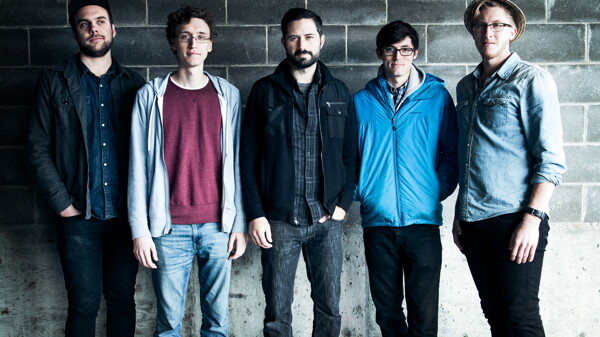Rising from the Dust
new band testifies to faith, taps alt-rock and folk roots
Jason Splichal, photos by Jen Schultz |

I’d like you to imagine a house: not just any house – a home. It’s a inviting home, even in the coldest of winters, filled with sunshine and the comforting roar of a fire burning steadily in the hearth. It’s the kind of home you hope to be invited to on Thanksgiving; the kind of home you’d love to wake up in on Christmas; the kind of home you’d feel comfortable laughing, crying, and sharing stories in. Now, imagine this home is built on an aggressive foundation of alternative rock, framed in with folk, and roofed with revival music – think Depression-era tin, O Brother Where Art Thou style.
This house, which always feels like a home, is actually one of Eau Claire’s newest bands: The Dust of Men. Their debut album, What the Morning Shows, is set to drop Dec. 6. Grant Schultz is on vocals, rhythm guitar, and piano; Colin Carey is on drums; Jon Wojcik is on banjo; John Roemhild is on bass; and Clark Strasburg (affectionately known as The Reverb Sherpa) is on lead guitar.
“I used to see music as something that expresses the unanswered ache in each of us, but writing these songs and playing with these guys, I discovered it’s not about the ache. It’s about the answer to that ache. It’s about the joy.” – Grant Schultz of The Dust of Men, on his musical evolution
The five-piece plays what they like to call “testimony music.” It would be remiss of me to call it Christian rock because they don’t, and it’s not. With Christian rock, the music is often simply a vehicle for its message, and that emphasis on message often comes at the expense of musical quality and diversity. While The Dust of Men is clearly on a journey together, from the darkness into light, their hauntingly powerful instrumentation stands shoulder to shoulder with Schultz’s soaring vocals and refined storytelling. What holds them together – the load-bearing wall in their home – is the genuine love that they have for each other and for their faith. This is deeply passionate and contagiously spiritual music. It appeals – regardless of one’s religious affiliations – to the core of what it means to be human: the questions, the struggle, and the hope.
Schultz, taking the long view on his own musical evolution, said as much: “I used to see music as something that expresses the unanswered ache in each of us, but writing these songs and playing with these guys, I discovered it’s not about the ache. It’s about the answer to that ache. It’s about the joy.”
What the Morning Shows is an auditory rollercoaster. While the band members’ eclectic influences – Sigur Ros, All the Bright Lights, Matthew and the Atlas, Radiohead, Bon Iver, Max Roach, The Roots, and This Will Destroy You – all decorate the rooms of this home, The Dust of Men has a sound all its own. Many of the songs were inspired by Schultz’s obsessive listening to the 1939 field recordings by John and Ruby Lomax, who preserved more than 700 songs on their year-long road trip through the Depression-era American South. “What got to me was how haunting, raw, and spare it was, and how nobody was apologizing for that,” Schultz said. All the band members agreed that those gritty, emotionally honest sounds – of both survival and revival – became the band’s creative starting line.
What evolved from there is a tour de force that can be witnessed in all of their live performances. Carey’s organic, heart-beat drumming lays the foundation for Roemhild’s stunningly dynamic bass work, which, in turn, creates an open floor plan for Wojcik to roam in and out of with his bright, crisp banjo work. Every room is painted with a thick coating of Strasburg’s buttery reverb and velvety guitar licks. The sunshine that floods the whole structure is the shocking range of Schultz’s vocal prowess; from smooth and measured to raw and unrestrained, his lyrical stylings are articulate and emotionally stirring. What the Morning Shows can feel old-timey with its jangly rhythms, gang vocals, and dirge drumming, but it can also feel lithe, elegant, and ultra-modern. The one common denominator is tone; it’s all so warm.
So how did the band manage to capture all that on a single record? They could not mention Zach Hanson’s name fast enough. Hanson recorded, mixed, and mastered the album at Justin Vernon’s secluded, world-class recording studio – April Base – while Volcano Choir was preparing for their current international tour. The band credits Hanson’s patient, intuitive, and meticulous work in the studio, as well as the natural warmth, isolation, and beautiful vintage equipment of April Base itself, for the album’s tonal signature. They testified repeatedly to how the kindness they were shown by Vernon and his crew – as well as the freedom they felt to simply be themselves in the studio – helped them to find their true sound as a band: a sound that music lovers in Eau Claire, and beyond, will likely find themselves “testifying” about very soon.
Release show for The Dust of Men’s What the Morning Shows CD • Friday, Dec. 6 • Valleybook Church, 412 S. Barstow St. • 7pm doors, 7:30pm show • FREE • www.facebook.com/thedustofmen




















